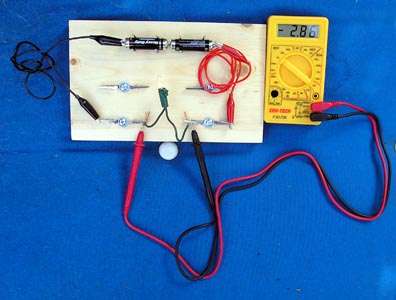
We'll start by building the "Circuit Workbench " Snack from the Book Square Wheels.
If you do not have a circuit workbench you may use a battery holder, leads with alligator clips on both ends (available at Radio Shack) and a bulb described next.
Then we'll connect a battery to a bulb cut from a string of 50 Christmas lightbulbs in series and measure the voltage across the bulb and current through the bulb.
Batteries Bulbs and Meters, How to use meters to measure voltage and current.
Estimating Errors in Measurement, Making a measurement with a meter changes the circuit being measured, here is how to estimate the change produced by the measurement.
Meters Current More detail on measuring current.Meters Voltage More detail on measuring voltage. We'll use meters to measure solar cells here.
Solar Cells, measure the power of a solar cell.
Meters Resistance, measure the voltage across and the current through a resistor and you can use ohms law to calculate its resistance.
Wire Model of Voltage, use chenille stems (pipe cleaners) to model the voltage around a circuit.
To go further exploring electricity try some of these activities.
Saltwater Battery How to build and use a low-power battery with salt water. there is also a snack named "Salt Water Pentacell" in the book Square Wheels which shows how to build salt water batteries.
Aluminum-Air Battery A more powerful battery using salt water.
Battery Dissection Cut apart a carbon zinc battery to see what is inside.
On models of electricity, a discussion of models of electric current.
Hand battery snack, measure the current created when your hands touch two different metal plates.
Quiet Lightning exhibit, This exhibit was built at the Exploratorium by artist in residence Bill Parker.
Neon Tubes exploration, these tubes run on high voltages but very low currents.
Making Battery Holders, there are several easy ways to hold batteries and connect wires to them.
Ammeter, build your own sensitive ammeter.
Electric Current Model, Use magnets to model the behavior of electric current.
Domino Model of a Nerve, Use a line of dominos to model the behavior of a nerve.
|
Scientific Explorations with Paul Doherty |
|
18 July 2006 |